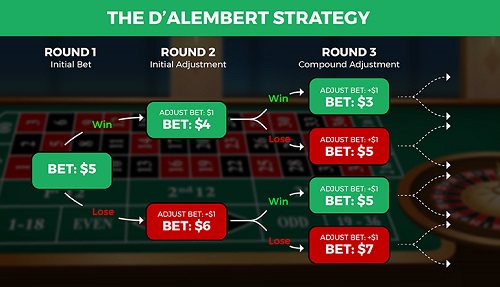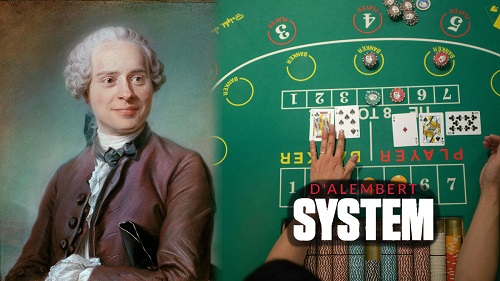Jennifer | January 18, 2023 | Updated on: February 1st, 2024
The D’Alembert betting system is one of the best betting strategies and comes highly recommended by us. The system can be used in games like roulette and some sporting events where even money bets apply.
The D’Alembert method can be grouped with negative progression betting systems because it’s based on the premise of increasing your wagers after every loss and decreasing it after every win. In this guide, we’ll explain how the system works and touch on the odds of winning when using this system.
Top Online Casino Sites
AU$10000 Bonus
+ 200 Free Spins
99% Payout
Rating: 4/5
99% Payout
Min Deposit: AU$10
AU$3000 Bonus
+ 100 Free Spins
98% Payout
Rating: 5/5
98% Payout
Min Deposit: AU$20
AU$5500 Bonus
+ 125 Free Spins
99% Payout
Rating: 5/5
99% Payout
Min Deposit: AU$10
AU$6750 Bonus
+ 250 Free Spins
98% Payout
Rating: 4/5
98% Payout
Min Deposit: AU$30
AU$2000 Bonus
+ 200 Free Spins
97% Payout
Rating: 4/5
97% Payout
Min Deposit: AU$20
AU$2500 Bonus
+ 250 Free Spins
98% Payout
Rating: 4/5
98% Payout
Min Deposit: AU$10
AU$6000 Bonus
+ 250 Free Spins
98% Payout
Rating: 5/5
98% Payout
Min Deposit: AU$15
AU$2000 Bonus
+ 200 Free Spins
98% Payout
Rating: 4/5
98% Payout
Min Deposit: AU$10
AU$3000 Bonus
+ 300 Free Spins
98% Payout
Rating: 4/5
98% Payout
Min Deposit: AU$20
AU$5000 Bonus
+ 75 Free Spins
99% Payout
Rating: 4.7/5
99% Payout
Min Deposit: AU$10
AU$7500 Bonus
+ 350 Free Spins
98% Payout
Rating: 5/5
98% Payout
Min Deposit: AU$30
AU$1670 Bonus
+ 600 Free Spins
98% Payout
Rating: 4.7/5
98% Payout
Min Deposit: AU$20
AU$7500 Bonus
+ 100 Free Spins
99% Payout
Rating: 5/5
99% Payout
Min Deposit: AU$20
AU$5000 Bonus
+ 300 Free Spins
98% Payout
Rating: 3/5
98% Payout
Min Deposit: AU$30
AU$4000 Bonus
+ 400 Free Spins
98% Payout
Rating: 3/5
Code: SKY125
Min Deposit: AU$30
AU$5000 Bonus
+ 300 Free Spins
98% Payout
Rating: 3/5
98% Payout
Min Deposit: AU$30
AU$3000 Bonus
+ 200 Free Spins
98% Payout
Rating: 3/5
98% Payout
Min Deposit: AU$20
AU$3000 Bonus
+ 225 Free Spins
98% Payout
Rating: 3/5
98% Payout
Min Deposit: AU$30
AU$750 Bonus
+ 100 Free Spins
98% Payout
Rating: 3/5
98% Payout
Min Deposit: AU$20
AU$4000 Bonus
+ 300 Free Spins
98% Payout
Rating: 4.7/5
98% Payout
Min Deposit: AU$30
AU$2500 Bonus
97% Payout
Rating: 4.8/5
98% Payout
Min Deposit: AU$25
AU$7000 Bonus
+ 200 Free Spins
98% Payout
Rating: 3/5
98% Payout
Min Deposit: AU$25
AU$3000 Bonus
+ 200 Free Spins
98% Payout
Rating: 3/5
98% Payout
Min Deposit: AU$30
AU$900 Bonus
+ 250 Free Spins
98% Payout
Rating: 4.7/5
98% Payout
Min Deposit: AU$15
AU$10000 Bonus
+ 200 Free Spins
98% Payout
Rating: 3/5
98% Payout
Min Deposit: AU$20
AU$750 Bonus
+ 200 Free Spins
98% Payout
Rating: 4/5
98% Payout
Min Deposit: AU$30
AU$8000 Bonus
+ 700 Free Spins
99% Payout
Rating: 3/5
99% Payout
Min Deposit: AU$30
AU$6000 Bonus
+ 200 Free Spins
99% Payout
Rating: 4.9/5
99% Payout
Min Deposit: AU$10
AU$1200 Bonus
+ 300 Free Spins
98% Payout
Rating: 3/5
98% Payout
Min Deposit: AU$15
AU$750 Bonus
+ 200 Free Spins
98% Payout
Rating: 4/5
98% Payout
Min Deposit: AU$15
AU$10,000 Bonus
+ 100 Free Spins
98% Payout
Rating: 3/5
98% Payout
Min Deposit: AU$30
AU$4000 Bonus
+ 150 Free Spins
99% Payout
Rating: 3/5
98% Payout
Min Deposit: AU$30
AU$750 Bonus
+ 200 Free Spins
98% Payout
Rating: 3/5
98% Payout
Min Deposit: AU$30
AU$7000 Bonus
+ 250 Free Spins
97% Payout
Rating: 3/5
97% Payout
Min Deposit: AU$10
AU$7500 Bonus
+ 550 Free Spins
98% Payout
Rating: 4.8/5
98% Payout
Min Deposit: AU$30
AU$6000 Bonus
+ 200 Free Spins
97% Payout
Rating: 3/5
97% Payout
Min Deposit: AU$10
AU$4000 Bonus
+ 475 Free Spins
98% Payout
Rating: 5/5
98% Payout
Min Deposit: AU$30
AU$10000 Bonus
+ 100 Free Spins
98% Payout
Rating: 4/5
98% Payout
Min Deposit: AU$30
AU$3000 Bonus
+ 200 Free Spins
98% Payout
Rating: 3/5
98% Payout
Min Deposit: AU$20
AU$4500 Bonus
+ 225 Free Spins
98% Payout
Rating: 3/5
98% Payout
Min Deposit: AU$30
AU$10000 Bonus
+ 500 Free Spins
98% Payout
Rating: 3/5
98% Payout
Min Deposit: AU$30
AU$10,000 Bonus
+ 100 Free Spins
99% Payout
Rating: 3/5
99% Payout
Min Deposit: AU$30
AU$5000 Bonus
+ 100 Free Spins
98% Payout
Rating: 3/5
98% Payout
Min Deposit: AU$20
AU$500 Bonus
+ 100 Free Spins
98% Payout
Rating: 5/5
98% Payout
Min Deposit: AU$25
AU$1500 Bonus
+ 500 Free Spins
98% Payout
Rating: 3/5
98% Payout
Min Deposit: AU$20
AU$2500 Bonus
+ 250 Free Spins
98% Payout
Rating: 3/5
98% Payout
Min Deposit: AU$20
AU$10,000 Bonus
+ 100 Free Spins
98% Payout
Rating: 3/5
98% Payout
Min Deposit: AU$20
AU$1500 Bonus
+ 100 Free Spins
99% Payout
Rating: 3/5
99% Payout
Min Deposit: AU$20
AU$750 Bonus
+ 200 Free Spins
98% Payout
Rating: 3/5
98% Payout
Min Deposit: AU$20
AU$4000 Bonus
+ 150 Free Spins
98% Payout
Rating: 3/5
98% Payout
Min Deposit: AU$20
AU$9000 Bonus
+ 200 Free Spins
97% Payout
Rating: 3/5
97% Payout
Min Deposit: AU$10
160% Bonus
+ 40 Free Spins
98% Payout
Rating: 4/5
98% Payout
Min Deposit: AU$20
AU$10,000 Bonus
+ 200 Free Spins
98% Payout
Rating: 3/5
98% Payout
Min Deposit: AU$30
AU$1500 Bonus
+ 200 Free Spins
98% Payout
Rating: 3/5
98% Payout
Min Deposit: AU$30
AU$7500 Bonus
+ 110 Free Spins
98% Payout
Rating: 3/5
98% Payout
Min Deposit: AU$10
250% Bonus
+ 50 Free Spins
98% Payout
Rating: 4/5
98% Payout
Min Deposit: AU$20
AU$1000 Bonus
+ 100 Free Spins
98% Payout
Rating: 3/5
98% Payout
Min Deposit: AU$10
AU$10000 Bonus
+ 200 Free Spins
98% Payout
Rating: 3/5
98% Payout
Min Deposit: AU$20
AU$1650 Bonus
+ 250 Free Spins
98% Payout
Rating: 3/5
98% Payout
Min Deposit: AU$20
AU$3,000 Bonus
+ 350 Free Spins
98% Payout
Rating: 3/5
98% Payout
Min Deposit: AU$30
AU$8000 Bonus
+ 250 Free Spins
98% Payout
Rating: 3/5
98% Payout
Min Deposit: AU$20
$600 Bonus
+ Free Spins
98% Payout
Rating: 3/5
98% Payout
Min Deposit: AU$
AU$5000 Bonus
+ 300 Free Spins
99% Payout
Rating: 3/5
99% Payout
Min Deposit: AU$10
AU$1250 Bonus
+ 75 Free Spins
98% Payout
Rating: 3/5
98% Payout
Min Deposit: AU$20
AU$500 Bonus
+ 100 Free Spins
98% Payout
Rating: 3/5
98% Payout
Min Deposit: AU$15
AU$1200 Bonus
+ 75 Free Spins
99% Payout
Rating: 3/5
99% Payout
Min Deposit: AU$10
AU$30,450 Bonus
+ 100 Free Spins
98% Payout
Rating: 3/5
98% Payout
Min Deposit: AU$20
AU$5000 Bonus
+ 100 Free Spins
97.6% Payout
Rating: 3/5
97.6% Payout
Min Deposit: AU$20
AU$4500 Bonus
+ 225 Free Spins
98% Payout
Rating: 3/5
98% Payout
Min Deposit: AU$30
AU$10000 Bonus
+ 150 Free Spins
99% Payout
Rating: 4/5
98% Payout
Min Deposit: AU$30
AU$1,200 Bonus
0 Free Spins
98% Payout
Rating: 3/5
98% Payout
Min Deposit: AU$26
AU$3000 Bonus
100 Free Spins
98% Payout
Rating: 3/5
98% Payout
Min Deposit: AU$15
AU$1000 Bonus
0 Free Spins
96% Payout
Rating: 3/5
96% Payout
Min Deposit: AU$26
AU$1,077 Bonus
0 Free Spins
97% Payout
Rating: 4/5
97% Payout
Min Deposit: AU$26
AU$1000 Bonus
0 Free Spins
97% Payout
Rating: 4/5
97% Payout
Min Deposit: AU$26
AU$800 Bonus
0 Free Spins
95% Payout
Rating: 3/5
95% Payout
Min Deposit: AU$26
AU$1500 Bonus
0 Free Spins
96% Payout
Rating: 3.5/5
96% Payout
Min Deposit: AU$26
AU$2500 Bonus
+ 200 Free Spins
98% Payout
Rating: 3/5
98% Payout
Min Deposit: AU$15
AU$1000 Bonus
+ 100 Free Spins
98% Payout
Rating: 5/5
98% Payout
Min Deposit: AU$20
AU$1500 Bonus
+ 25 Free Spins
98% Payout
Rating: 4.8/5
98% Payout
Min Deposit: AU$20
AU$1,500 Bonus
$5 Casino Bonus
96% Payout
Rating: 4/5
96% Payout
Min Deposit: AU$25
AU$1,500 Bonus
$25 Bingo Bonus
95% Payout
Rating: 3/5
95% Payout
Min Deposit: AU$25
AU$1000 Bonus
+ 250 Free Spins
99% Payout
Rating: 3/5
99% Payout
Min Deposit: AU$20
AU$2000 Bonus
+ 90 Free Spins
98% Payout
Rating: 4/5
98% Payout
Min Deposit: AU$20
AU$3000 Bonus
+ 100 Free Spins
97% Payout
Rating: 3/5
97% Payout
Min Deposit: AU$20
AU$15000 Bonus
+ 225 Free Spins
98% Payout
Rating: 3/5
98% Payout
Min Deposit: AU$20
AU$2000 Bonus
+ 200 Free Spins
97% Payout
Rating: 4.7/5
98% Payout
Min Deposit: AU$10
300% Bonus
+ 250 Free Spins
98% Payout
Rating: 3/5
98% Payout
Min Deposit: AU$10
AU$38000 Bonus
+ 300 Free Spins
98% Payout
Rating: 4.8/5
98% Payout
Min Deposit: 0.0001 BTC
AU$1500 Bonus
+ 200 Free Spins
97% Payout
Rating: 3/5
97% Payout
Min Deposit: AU$15
AU$4000 Bonus
+ 100 Free Spins
97% Payout
Rating: 4.8/5
97% Payout
Min Deposit: AU$10
AU$1200 Bonus
+ 50 Free Spins
98% Payout
Rating: 4.7/5
97% Payout
Min Deposit: AU$10
AU$2000 Bonus
+ 100 Free Spins
98% Payout
Rating: 4/5
98% Payout
Min Deposit: AU$15
AU$7777 Bonus
98% Payout
Rating: 4.7/5
98% Payout
Min Deposit: AU$10
AU$5000 Bonus
96% Payout
Rating: 4.5/5
98% Payout
Min Deposit: AU$20
AU$3000 Bonus
96% Payout
Rating: 3/5
96% Payout
Min Deposit: AU$20
AU$4000 Bonus
+ 300 Free Spins
98% Payout
Rating: 4.5/5
98% Payout
Min Deposit: AU$15
AU$800 Bonus
+ 120 Free Spins
98% Payout
Rating: 4.8/5
98% Payout
Min Deposit: AU$20
AU$8888 Bonus
+ 350 Free Spins
97% Payout
Rating: 4.8/5
97% Payout
Min Deposit: AU$20
AU$2500 Bonus
+ 500 Free Spins
97% Payout
Rating: 4.8/5
97% Payout
Min Deposit: AU$20
AU$675 Bonus
+ 250 Free Spins
97% Payout
Rating: 3/5
97% Payout
Min Deposit: AU$20
750% Bonus
+ 110 Free Spins
97% Payout
Rating: 4.8/5
97% Payout
Min Deposit: AU$20
AU$750 Bonus
+ 110 Free Spins
97% Payout
Rating: 4.8/5
97% Payout
Min Deposit: AU$20
AU$750 Bonus
+ 110 Free Spins
98% Payout
Rating: 4.8/5
98% Payout
Min Deposit: AU$25
AU$7500 Bonus
+ 100 Free Spins
98% Payout
Rating: 3/5
98% Payout
Min Deposit: AU$30
AU$3000 Bonus
+ 350 Free Spins
97% Payout
Rating: 3/5
97% Payout
Min Deposit: AU$30
AU$12500 Bonus
+ 55 Free Spins
97% Payout
Rating: 3/5
97% Payout
Min Deposit: AU$30
D’Alembert System Page Guide
- How the D’Alembert System Works
- D’Alembert Betting System Rules
- Does the D’Alembert System Work?
- D’Alembert System Origins
The Gamblers Fallacy
Before discussing the betting system in question, we first want to touch on a theory called The Gamblers Fallacy because the D’Alembert system is a strong by-product of this theory. The Gamblers Fallacy, is the flawed belief that if something is happening more frequently now than it has in the past, the likelihood of it continuing to happen in the future decreases (and vice versa). This reasoning is based on the idea that what happens in the future is affected by what happened in the past.
But, many events have happened that proved that this fallacy is not true. Past events in no way influence the probability of future events despite what some strategies argue. E.g. if the number 28 comes up in three consecutive lottery draws, you cannot be 100% certain that it will come up a fourth time. If it does, it’s purely coincidence.


D’Alembert then fell for this fallacy and argued the probability of a coin landing on heads increases the more the opposite occurs, which is it landing on tails. When we apply this theory to the roulette game, he assumed that you should win even money bets, almost equally as much as you lose an even money bet. More specifically, if you made a simple colour bet on red, the chances of black coming up over the same period should be more or less the same.
How the D’Alembert System Works
As mentioned previously, this system can be applied to games that have even money bets. Even money bets refer to bets that have an equal chance of occurring. Red/black, odd/even bets in roulette, and moneyline bets in sports betting are examples of bets where this system works best.
But, for the sake of keeping it simple, we’ll stick to the coin toss example mentioned above. The system suggests that you shouldn’t change your bet to heads if you bet on tails and heads came out. Instead, stick to tails but this time, increase your wager amount by 1 unit.
For example, if you bet $10 on tails the first time around and lost, your next wager should be $20 on tails. So, increasing your wager by 1 unit means you add your base wager amount to your next bet and continue to do so each time you lose.
If you win at any point, you must decrease your wager amount by 1 unit. So, if you won on the $20 wager, your next wager would be $10, as this is one unit lower than your previous bet.
D’Alembert Betting System Rules
We’ve listed some of the rules of using the system. Have a look at what they are below:
- The first rule of play is to decide what your winning goal is. This involves setting an amount and sticking by it.
- You must begin your game with one unit bets.
- If results are tied one round, you must play the same bet amount again.
- Bet sizes are to be decreased after every win
- Bet sizes should increase after every loss.


Does the D’Alembert System Work?
Does this system work, or was D’Alembert just another victim to the Gamblers Fallacy theory? The answer to this is more of a personal preference than a straightforward yes or no. You get players who stand firm in advocating for its effectiveness, while other players have their doubts. We believe there’s some truth to both arguments.
Sticking to the coin toss situation – the more heads come up, the more you expect tails to appear because the possibility of just heads coming up every time seems too good to be true. At some point, the expectation of the tables turning is something we cannot help but anticipate.
But, expecting the results of both heads and tails to be equal is asking for too much. Probability and chance is just not that clear cut. It does happen that both heads and tails occur the same amount of times; it’s a miraculous coincidence. Chance does not allow us to make accurate predictions on what’s to come based on what happened in the past because the past does not influence what’ll happen in the future.
Believing that it does is like believing that luck has a memory and keeps track of when it struck. We’ll also be assuming that luck is fair. Looking at real life, I think it’s fair to say that it isn’t.
D’Alembert System Origins
Every theory or betting system comes from somewhere. This particular system was created by a man named Jean-Baptiste le Rond d’Alembert. History marks him down as a man of all trades. Jean-Baptiste made valuable contributions to physics, mathematics, philosophy and even music.
One of his famed arguments is a tossed coin that we’ve mentioned several times in this guide. Jean was a firm believer of the gambler’s fallacy and essentially developed the D’Alembert betting system to prove that trend betting works.




























































































































